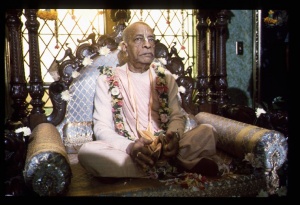SB 9.24.66

A.C. Bhaktivedanta Swami Prabhupada
TEXT 66
- jāto gataḥ pitṛ-gṛhād vrajam edhitārtho
- hatvā ripūn suta-śatāni kṛtorudāraḥ
- utpādya teṣu puruṣaḥ kratubhiḥ samīje
- ātmānam ātma-nigamaṁ prathayañ janeṣu
SYNONYMS
jātaḥ — after taking birth as the son of Vasudeva; gataḥ — went away; pitṛ-gṛhāt — from the houses of His father; vrajam — to Vṛndāvana; edhita-arthaḥ — to exalt the position (of Vṛndāvana); hatvā — killing there; ripūn — many demons; suta-śatāni — hundreds of sons; kṛta-urudāraḥ — accepting many thousands of wives, the best of women; utpādya — begot; teṣu — in them; puruṣaḥ — the Supreme Person, who exactly resembles a human being; kratubhiḥ — by many sacrifices; samīje — worshiped; ātmānam — Himself (because He is the person worshiped by all sacrifices); ātma-nigamam — exactly according to the ritualistic ceremonies of the Vedas; prathayan — expanding the Vedic principles; janeṣu — among the people in general.
TRANSLATION
The Supreme Personality of Godhead, Śrī Kṛṣṇa, known as līlā-puruṣottama, appeared as the son of Vasudeva but immediately left His father's home and went to Vṛndāvana to expand His loving relationship with His confidential devotees. In Vṛndāvana the Lord killed many demons, and afterwards He returned to Dvārakā, where according to Vedic principles He married many wives who were the best of women, begot through them hundreds of sons, and performed sacrifices for His own worship to establish the principles of householder life.
PURPORT
As stated in Bhagavad-gītā (BG 15.15), vedaiś ca sarvair aham eva vedyaḥ: by all the Vedas, it is Kṛṣṇa who is to be known. Lord Śrī Kṛṣṇa, setting an example by His own behavior, performed many ritualistic ceremonies described in the Vedas and established the principles of gṛhastha life by marrying many wives and begetting many children just to show people in general how to be happy by living according to Vedic principles. The center of Vedic sacrifice is Kṛṣṇa (vedaiś ca sarvair aham eva vedyaḥ). To advance in human life, human society must follow the Vedic principles personally demonstrated by Lord Kṛṣṇa in His householder life. The real purpose of Kṛṣṇa's appearance, however, was to manifest how one can take part in loving affairs with the Supreme Personality of Godhead. Reciprocations of loving affairs in ecstasy are possible only in Vṛndāvana. Therefore just after His appearance as the son of Vasudeva, the Lord immediately left for Vṛndāvana. In Vṛndāvana, the Lord not only took part in loving affairs with His father and mother, the gopīs and the cowherd boys, but also gave liberation to many demons by killing them. As stated in Bhagavad-gītā (BG 4.8), paritrāṇāya sādhūnāṁ vināśāya ca duṣkṛtām: the Lord appears in order to protect the devotees and kill the demons. This was fully exhibited by His personal behavior. In Bhagavad-gītā the Lord is understood by Arjuna to be puruṣaṁ śāśvataṁ divyam—the eternal, transcendental Supreme Person. Here also we find the words utpādya teṣu puruṣaḥ. Therefore it is to be concluded that the Absolute Truth is puruṣa, a person. The impersonal feature is but one of the features of His personality. Ultimately, He is a person; He is not impersonal. And not only is He puruṣa, a person, but He is the līlā-puruṣottama, the best of all persons.